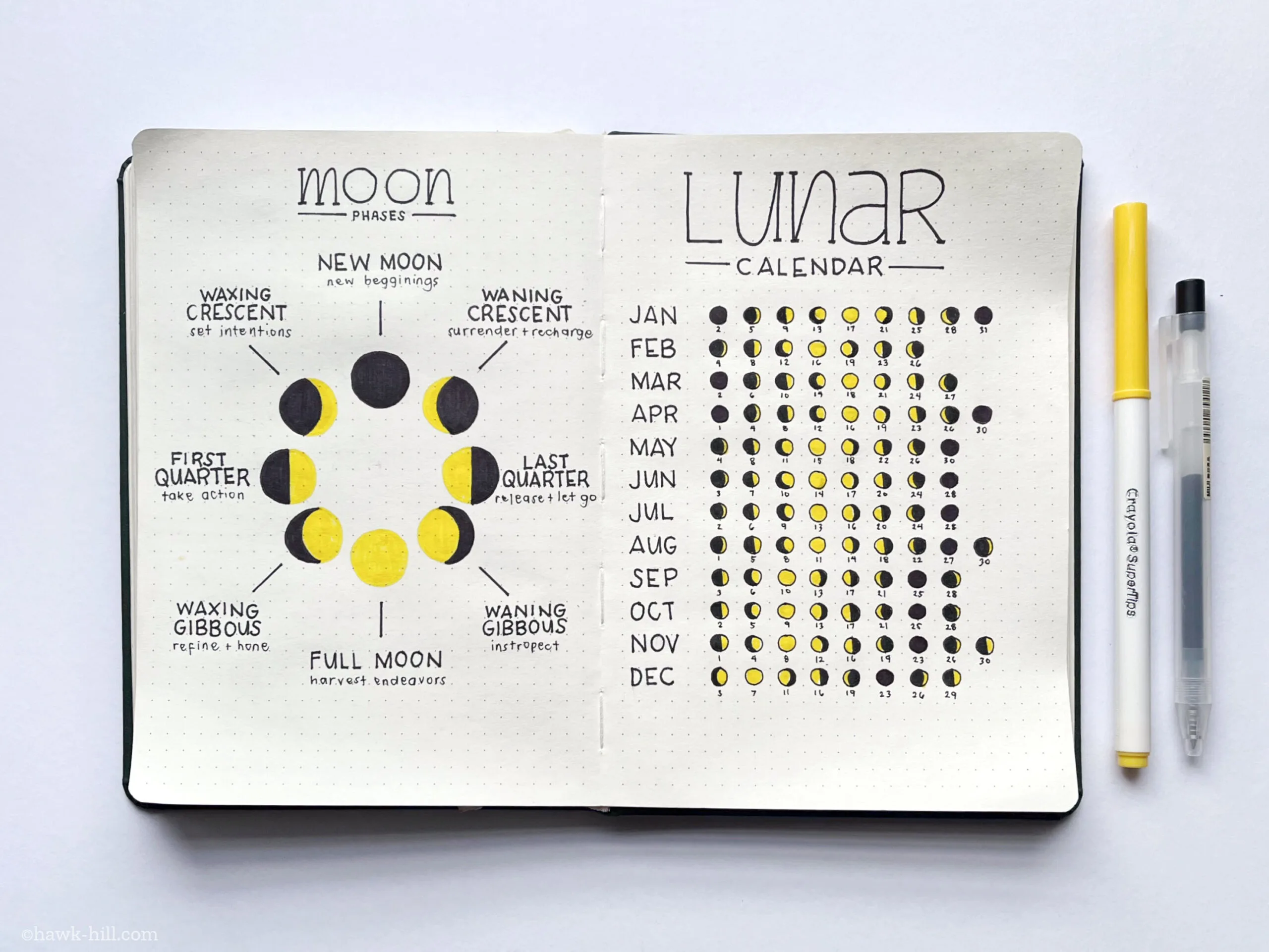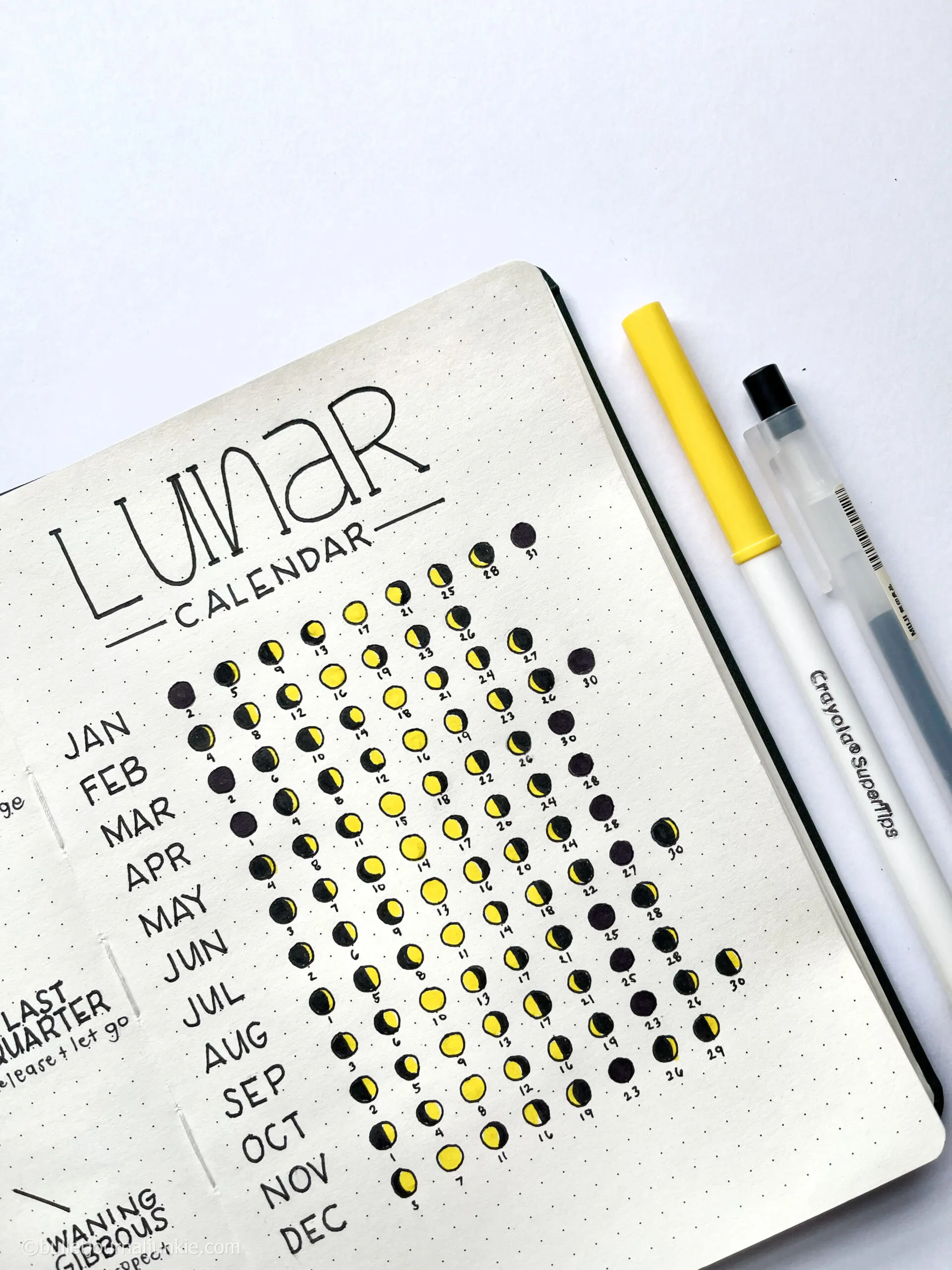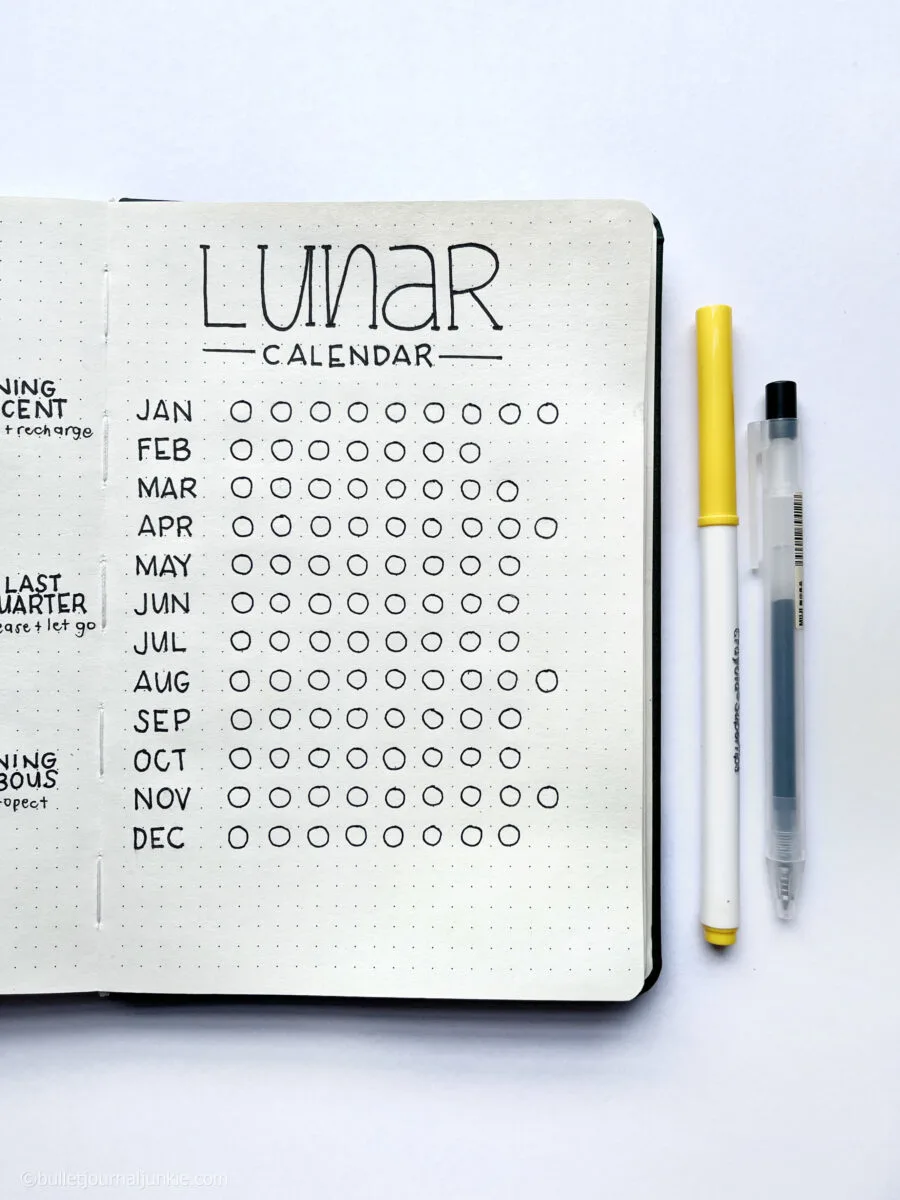Feeling ready to throw caution to the wind and howl at the moon? Maybe it’s the lunar cycle! Many highly sensitive and intuitive people believe their moods, creativity, and hormones cycle with the lunar calendar. Today, I’m sharing with you a lunar calendar bullet journal layout that can perk up your bullet journal spread and inspire you to tune in to your cosmic alignment.
In this article, you’ll discover:
- a printable PDF of my lunar calendar layout that you can download for free
- how the lunar calendar layout helps in goal-setting and mindfulness
- steps on how to create and use your lunar calendar spread
- things you can add and tweak to personalize your lunar calendar layout!

In the past, I preferred using the standard day calendar in my bujo since it is consistent with the schedule of my daily activities. However, I stumbled upon this lunar calendar layout that instantly gave off a unique vibe and I fell in love right away. There’s more to this moon phases layout than simply ✨aesthetic ✨ journal pages. After reading this article, may also change your mind about this interesting calendar layout.
What A Moon Cycle Bujo Layout Is All About
The moon calendar layout is a bullet journaling spread that is inspired by the cycles of the moon. Each “cycle” or “phase” represents a particular season or theme in your life that you want to highlight in your journal. For each cycle (equivalent to a couple of days in the Gregorian calendar), you’ll shade the moon diagram using keys resembling the phases of the moon.
The main difference between this tracker and the bullet journal layouts for your dailies is that the “days” are numbered according to the moon cycle. For instance, if tonight is a new moon, the next cycle would be on July 7, when the moon will then appear in the first-quarter phase.
How Tracking the Lunar Cycle Layout May Help in Goal-Setting and Mindfulness
Although some research solidly argues that the moon doesn’t really influence people’s behavior 1 2 3 , some journalers who are also into astrology believe that the moon cycles somehow play a role in fulfilling our intentions. This makes the lunar calendar layout a fitting tribute to the cosmic energies guiding our lives.
In many ancient beliefs, the moon cycle serves as a reminder of changes in the season. In fact, the Chinese hold their harvest season during the autumn full moon. Journalers became inspired by this and now we can follow a timeline for realizing our goals as the lunar cycle.
Think of the lunar calendar layout as a guide to what could be the next cycle, routine, or stage of your life. Doing so may help you to stay in the present and reflect with mindfulness on the stage you’re currently in.
Lunar Calendar Keys for Every Life Season
In this layout, you will use different moon shapes to represent specific moods or themes. The description for each moon phase may differ from one journaler to another, although I prefer to use meanings that reflect my personal understanding of how moon cycles influence my mood.
Here’s what each moon phase means:
- 🌑 New Moon – represents new beginnings
- 🌘 Waning Crescent – represents surrender and recharge
- 🌗 Last Quarter – represents release or letting go (of ill feelings, relationships, pursuits)
- 🌖 Waning Gibbous – represents introspection
- 🌕 Full Moon – represents the harvest of endeavors
- 🌔 Waxing Gibbous – represents refining and honing (of crafts, skills, etc.)
- 🌓 First Quarter – represents taking action
- 🌒 Waxing Crescent – represents setting intentions
Doing this moon cycle layout for the first time can be messy and time-consuming. If you’re busy or you just want to see if it’s something you’d like to keep in your journal, you can use this printable PDF of the lunar calendar layout as a pattern or a trial page.
How to Use The Lunar Calendar Layout in Your Journal
If you’re feeling adventurous and want to enjoy the DIY process, here’s a step-by-step instruction for creating the lunar calendar layout.

How to Use The Lunar Calendar Layout in Your Journal
Total Time: 2 minutes
Draw the lunar calendar on the right page of the journal spread

Draw nine small circles about the same size as a single square across the dotted page. This will ensure that there’ll be enough lunar cycles to be recorded for each month. Leave a little room on the page for labeling dates and months.
Write the months and dates

On either side of the circle diagrams, write the months in a column format. Then, underneath the circles, indicate the dates of each lunar cycle. Refer to a reliable lunar calendar source to know which circles you’ll need to label.
Don’t worry if the dates don’t look consistent across the lunar months. Remember that they are dependent on the actual moon phases as seen in the skies.
Add the key

On the left page of the bullet journal spread, draw a bigger version of the moon diagrams. Indicate their phases by coloring portions of the circles or their entirety. Label each diagram with its corresponding moon phase (e.g. 🌑 = “New Moon”, 🌒 = “Waxing Crescent”).
Under each moon phase label, indicate the meaning of the said phase. In my case, I used “New Moon” to symbolize “new beginnings”. The placements of the circles will remind you which phase is next in line and draw inspiration from it to establish your goal progression.
Decorate Your Moon Bullet Journal Page

Get as creative as you want by adding astrology-themed doodles or stickers such as stars and planets. Make sure they stand out by giving them galaxy colors.
Supply:
- Bullet Journal
- Fine tip pen
- yellow marker or colored pencil
Variations for the Lunar Calendar Bullet Journal Layout
My version of the lunar calendar layout helps me look forward to the next cycle as I align my goal progression with the moon phases. But a few users opt to use the moon phases as individual keys to represent daily moods. Regardless of the actual appearance of the moon in the sky, you can adopt the moon phases like the new moon and waxing crescent to symbolize “inspired” and “reflective” moods.
Other designs of this layout include more elaborate moon diagrams. I discovered some diagrams where the moon can be a smiling emoji on a full moon or a sleeping banana-shaped moon on a waxing crescent. There are also those who use round stickers that they can shade according to the current moon phase.

How Often to Use the Lunar Calendar Layout in a Journal
Your lunar calendar layout covers the whole lunar year so you’ll only likely use a single spread from your bullet journal. The frequency of use will depend on the dates assigned for the lunar cycles. This means that you don’t need to shade your moon diagrams until a few days toward the next cycle.
Even if you need to wait for the moon phases to change, you can still use the days to reflect on what the current cycle represents in your life. On the next moon phase, you’ll move on to another stage of your goal progression as well.
When Should You NOT Use the Lunar Calendar Layout
While I don’t see any reason why you should not use a lunar calendar layout, some journalers find the dates inconsistent with the actual moon phases. It’s not a big deal, though. I recommend just indicating the dates of the lunar cycle as you see it in the sky.
If you find the layout a bit confusing to keep, you may simply stick with your daily bullet journal trackers and organizers. You may also choose to not follow the moon phases and treat the keys as you would your daily mood trackers. Just draw on the hollow moon diagrams the current moon phase representing your mood for the day.

Final Thoughts on Using the Lunar Calendar Layout in 2022
Thanks to Tiktok and Instagram reels, there’s currently a huge interest in astrology-themed bullet journal spreads. Hence, using a lunar calendar layout in 2022 is still trendy and even more relevant. In this article, you have learned how to use the lunar calendar layout for goal-setting and mindfulness, as well as creating variations and decorating this bullet journal spread.
Image Description for Screen Readers
The photo shows a bullet journal spread for the lunar calendar layout. The left page is entitled “Moon Phases”. Below are moon diagrams in their lunar cycle. Clockwise from the “New Moon” diagram are “Waning Crescent”, “Last Quarter”, “Waning Gibbous”, “Full Moon”, “Waxing Gibbous”, “First Quarter”, and “Waxing Crescent”.
Clockwise from the New Moon, the labels underneath each moon diagram say “new beginnings”, “surrender & recharge”, “release & let go”, “introspect”, “harvest endeavors”, “refine & hone”, “take action”, and “set intentions”.
The right page is entitled “Lunar Calendar”. Below is a lunar calendar with moon diagrams shaded according to lunar cycles. The left column of the page indicates the months. Next to each month are dated moon diagrams.
The moon diagrams on both pages are shaded black and yellow.
Sources
- Chaput, J. P., Weippert, M., LeBlanc, A. G., Hjorth, M. F., Michaelsen, K. F., Katzmarzyk, P. T., … & Sjödin, A. M. (2016). Are children like werewolves? Full moon and its association with sleep and activity behaviors in an international sample of children. Frontiers in pediatrics, 4, 24. [↩]
- Thompson, D. A., & Adams, S. L. (1996). The full moon and ED patient volumes: unearthing a myth. The American journal of emergency medicine, 14(2), 161-164. [↩]
- https://journals.lww.com/pec-online/FullText/2014/12000/Pediatric_Psychiatric_Emergency_Department_Visits.6.aspx [↩]
